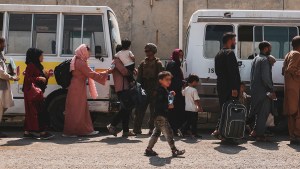Talib means, literally, “student.” More specifically, the term refers to someone studying in a madrassah, a Islamic religious school. The plural form of talib in Pashto is taliban —a term loaded with several different layers of tradition and history. In Sunni Islam, the “Taliban” are those who scrupulously adhere to the legal, moral and ritual standards of Islamic doctrine. In the Shiite tradition, the word talib often refers instead to someone occupying one of the lowest ranks of the clerical hierarchy.
Although the figure of the talib (and that of the Taliban) is somehow present all throughout Islamic history, the term became popularly known (for several reasons) during the 20th century. From Indonesia to Morocco and from Afghanistan to Senegal, the term is linked to different anti-colonialist movements. These movements were seen by some as part of an “awakening” (nahda) of the Islamic world, attempting to get rid of different forms of Western domination, aiming to return to the original principles of Islam (salafiyah). In these movements, the Taliban found both a source of inspiration and a way of acting.
Openly embracing and promoting scientific and technical advances (wherever they come from) these movements sharply differentiate science from westernization —the latter considered as being inherently opposed to their understanding of Islamic culture. These principles were successfully adopted and used by several different nationalist and anti-colonial movements after 1945, shaping the political evolution of the Arab world in the 20th century.

At the end of the century, the Taliban reappeared as a political movement on the rise. This, for two fundamental reasons: the failure of early Islam-inspired nationalist governmental models on the one hand, and the geopolitical restructuration of the world following the end of the Cold War, on the other. In this context of both domestic and international division and struggle for geopolitical control of the area, the Afghan Taliban movement began to thrive.
Most of these “students” had been refugees from the Afghan war against the Soviet (1979-89), raised and educated in madrassahs financed by Saudi Arabia in western Pakistan, advised by the Pakistani secret services with the support of the CIA. The political international panorama included not only US-USSR tensions, but also a Sunni struggle against Khomeini’s Shiite Iran.
This generation of Afghan refugees, forcefully away from their homeland, found in the Islam they were formed while in exile their only identity reference —an Islam determined by a strong sense of hierarchy and community, stark obedience to the leader, submission to Islamic law, and defense of the Islamic identity of Afghanistan. In sum, a doctrine based in Islamic-nationalist elements, which would exclude anyone who did not partake in it.
How did the Taliban come to power?
The rise of the Taliban is closely related to the decline and eventual disintegration of Soviet domination in Central Asia. In Afghanistan, the Mujahideen (that is, Islamist militants) were unable to establish themselves as a political, governmental alternative. The Pakistani government understood the rising instability in the region as threatening their own political and economic interests, which coincided with those of large international corporations —mainly, American ones. The rise of the Taliban was seen as a guarantee of, at the very least, some stability.
Between 1994 and 1996, the Taliban’s advance was aided not only by international powers, but also by domestic, traditional Afghan social and political structures. These structures were nevertheless gradually replaced by new ones, promoted by the Taliban ruling class. Mullah Úmar, the top figure of the Taliban movement, was named the highest Muslim authority, via oath of allegiance (baia), in April 1996. Later that year, in September, the Taliban took Kabul. This event made clear the Taliban had the capacity to fill the power vacuum generated by the disintegration of the all-too-weak Afghan secular State, which was utterly dependent on external powers. For many, the Taliban was the great Islamic hope.
Faced with Western pressure, the Taliban decided to monopolize political, economic, and military power. They refused to establish any contact with other political forces within the country, and imposed their understanding of both civil rules (muamalat) and the penal code (hudud).
Political reasons (and not cultura, or religious ones) led the Taliban to practice outright intolerance of the ethnic, social, political and cultural diversity that once characterized Afghan society. This was also the reason their dominance eventually weakened in some far regions of the country —they certainly lost internal support. The Taliban imposed a hierarchical military system, which destroyed delicate inter-ethnic balance arrangements, state structures, and mechanisms of civil participation. There was no alternative to their central power, which was (as is always the case) supported by a clientelist network.
Taliban power eventually managed to build ideological bridges with other movements, including that of Osama Bin Laden (Al-Qaida), which promoted the ideological preparation for a jihad aimed at the liberation of territories from which Islamists expansion would be possible. This alliance definitely ushered in the war against the Taliban regime. On the one hand, their support of Bin Laden, even after the 9/11 terrorist attack in New York City, completely destroyed their geostrategic relations with the United States. On the other, Pakistan considered the Taliban government had done more harm than good for the region. For these reasons, the international military intervention did not find much opposition when it decided to overthrow the Taliban.
But, having outlasted a powerful international military coalition led by the US for more than two decades, the Taliban soon regained control on vast zones of the country, and managed to topple the Kabul government as soon as foreign powers began to withdraw. They easily swept across Afghanistan in 10 days. This blitzkrieg-like advance impelled tens of thousands of Afghan citizens to flee their homes, either heading for Kabul or neighboring countries.


